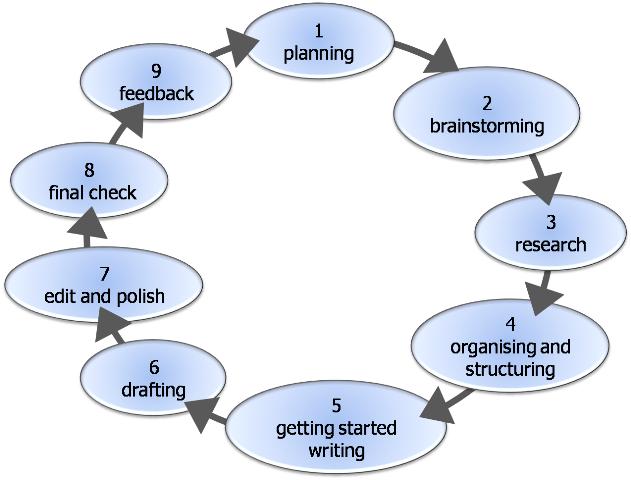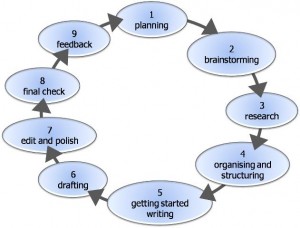
The Life Cycle of a Note
February 2, 2012Student Blogs Article How does a student note proceed along the path from idea to publication? Since only two or three notes are selected for publication in each issue of a given journal, there is a considerable narrowing of the field. Associate members of the three print journals at Cornell have two types of responsibility: editing and writing. To satisfy the writing component, most associates choose to write traditional notes, long scholarly papers about a current legal issue, with the hope of possibly being selected for print publication. (Now JLPP offers an innovative alternative venue for publication—this student blog.)
How does a student note proceed along the path from idea to publication? Since only two or three notes are selected for publication in each issue of a given journal, there is a considerable narrowing of the field. Associate members of the three print journals at Cornell have two types of responsibility: editing and writing. To satisfy the writing component, most associates choose to write traditional notes, long scholarly papers about a current legal issue, with the hope of possibly being selected for print publication. (Now JLPP offers an innovative alternative venue for publication—this student blog.)
On this journal, a class of 50+ associates means that the Note Committee has no small number of notes to evaluate. Sarah Hack, Senior Note Editor (SNE) for JLPP, provided some insight into a JLPP note’s progression, which is guided in part by the journal by-laws, as well as by protocol developed by the Notes Committee and Sarah herself. For the first issue of JLPP’s three-per-year, the pool of submissions is comprised solely of the notes written by the current class of associates. The outgoing Note Editors from the previous year recommend their top choices, and the incoming Note Committee evaluates them. For the second and third issues of JLPP’s three, the Note Committee provides feedback to the authors that request it if their notes were not selected for publication the first time around. The Committee evaluates these revised notes, as well as completely new submissions from other members of the CLS student body.
Sarah said that she was “drawn to notes that represented a unique student perspective, or a uniquely Cornell or upstate New York issue.” Especially well-researched, creative, humorous, and readable notes also had a strong shot at publication. Editing of the selected notes, from the initial sourcing and proving by the associates, to the Articles Editors, Managing Editors, and all the way up to the Editor-in-Chief, allows the student associates to gain valuable editing experience. Despite the multiple hands involved at every stage of the process, the JLPP Note Committee still wants the authors of the published notes to be involved.
Sarah’s ideal goal would be for every student note written by a JLPP associate to be published somewhere—if not in JLPP, then in another journal at Cornell, in an outside journal (which might establish relationships with other leading public policy journals), or in less traditional or even non-legal periodicals. But she understands that not all students want their notes published. In fact, one of the motivating factors behind the blog was to offer a broader, more informal avenue for student writing and dissemination of ideas.
The note selection procedure is a bit different for Cornell’s International Law Journal (ILJ), as its Senior Note Editor Julia Copping explained. The ILJ Notes Committee, consisting of the Senior Note Editor, Notes Editors, and Editor-in-Chief, hold a single meeting to select notes for publication. The Committee uses several factors to evaluate the notes, including the topic’s originality, legal argument, the depth of research involved, the writing style, and international relevance. The illustrious Sue Pado, administrative assistant for Cornell’s three print journals, solicits submissions related to international issues three weeks prior to the ILJ meeting, of which the Committee keeps a detailed record. The ILJ SNE then meets with the chosen authors to discuss the comments and critiques offered by the Notes Committee. According to Julia, the authors are generally happy to implement the suggestions. The student author is then responsible for the initial sourcing and proving, after which the ILJ Article Editor, Managing Editors, author, and Editor-in-Chief further edit the note before publication. Julia said that the ILJ note process is designed “both to provide a learning experience for ILJ members (improves research, writing, and bluebooking skills), and to recognize student work through publication.” ILJ and JLPP both solicit notes broadly, but most submissions come from the Journals’ staff members and the CLS community.
According to Kerry Harnett, the Senior Note Editor for the Cornell Law Review (CLR), note selection and editing methods are, for the most part, similar to those of the other two journals, though there are some different practices in place. After Sue Pado removes all identifying information from the notes and the SNE divides the submissions among the Notes Editors, each CLR Note Editor can select up to two notes to send to the final round, during which all the top-2s are reviewed by the Final Committee, comprised of the Note Editors and the Editor-in-Chief. Kerry said that CLR selects for publication based on such criteria as the note’s novelty, depth of analysis, timeliness, and the amount of technical editing required. The CLR associates do the initial technical editing and proving, fixing typos, Bluebooking errors, and formatting while ensuring that all of the citations are correct. Next, Managing Editors review the note in its entirety—each note is reviewed by three CLR ME’s before publication. Student authors have the final say, but they often defer to the ME’s suggestions. Notes that are not published are returned with feedback so that the authors can revise them in order have a better chance at publication with resubmission. Although Kerry devoted a lot of time and energy to CLR, she “wishes she worked harder on her note as an associate,” because she never “had time to make it what she wanted it to be.”
While the journey from initial idea all the way to published note varies from journal to journal, the life cycle of a note is never dull. With scores of actors and numerous stops and procedures involved on the path to publication, there exists quite a bit of complexity behind the final product printed in a journal.
You may also like
- April 2024
- March 2024
- February 2024
- November 2023
- October 2023
- April 2023
- March 2023
- February 2023
- January 2023
- December 2022
- November 2022
- October 2022
- May 2022
- April 2022
- March 2022
- February 2022
- January 2022
- December 2021
- November 2021
- October 2021
- May 2021
- April 2021
- March 2021
- February 2021
- January 2021
- November 2020
- October 2020
- September 2020
- August 2020
- July 2020
- June 2020
- May 2020
- April 2020
- March 2020
- February 2020
- January 2020
- November 2019
- October 2019
- September 2019
- April 2019
- February 2019
- December 2018
- November 2018
- October 2018
- September 2018
- March 2018
- February 2018
- January 2018
- December 2017
- November 2017
- October 2017
- September 2017
- May 2017
- April 2017
- March 2017
- February 2017
- December 2016
- November 2016
- October 2016
- April 2016
- March 2016
- February 2016
- January 2016
- December 2015
- November 2015
- October 2015
- June 2015
- May 2015
- April 2015
- March 2015
- February 2015
- January 2015
- December 2014
- November 2014
- October 2014
- August 2014
- March 2014
- February 2014
- January 2014
- December 2013
- November 2013
- October 2013
- September 2013
- May 2013
- April 2013
- March 2013
- February 2013
- January 2013
- December 2012
- November 2012
- October 2012
- September 2012
- June 2012
- April 2012
- March 2012
- February 2012
- January 2012
- December 2011
- November 2011
- October 2011
- September 2011
- August 2011
- April 2011
- March 2011
- November 2010
- October 2010
- September 2010
